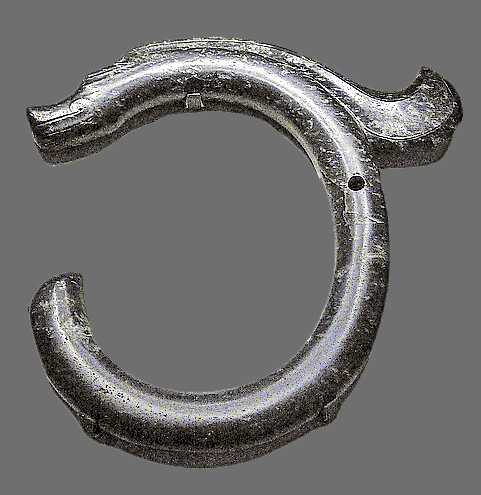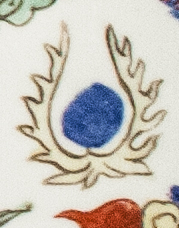
|
DRAGONS are important in ancient China for three reasons. (1) They are part of the earliest cosmological iconography that we have from Chinese culture. (2) They are heavenly creatures who help mediate the mandate of heaven. (3) They are confabulated with bi and other ritual artifacts. What follows is my own personal classification of Neolithic dragons and some notes on what becomes of them as Chinese culture is elaborated through the ages. |
||
|
SACRED FISH |
||
|
|
Five Neolithic dragons. This Neolithic carving of a fish displays five kinds of dragon, stylistically well differentiated 6,000 to 8,000 years ago. (1) The eyebrow of the fish is the long, Tao tei dragon that soon becomes the face of ritual bronzes. (2 & 3) Behind the gill, there are two blocky cloud dragons. (4) Below the dorsal fin of the fish, is a J-shaped dragon with a long crest that comes to adorn many bi. (5) At the base of the tail is the "pig" dragon that become integrated with bi. |
|
|
|
|
| Fish have a long association with the divine in China. On the belly of the red agate fish above, you will see a creature with large eyes and horns. This is the Tao Tei, the beast that is common on Shang Dynasty bronzes. A more detailed drawing of the Tao Tei is on the Neolithic period fish immediately aove. Above to the right, a Yuan Dynasty fish supports a dragon on his dorsal fin. Immediately to the right, is a fish with the head of a dragon. | 
|
|
PIG DRAGONS |







CLICK ON THE SMALL IMAGES TO ENLARGE THEM. |
|
|
These are commonly called "Pig" dragons because of their general likeness to a pig. The first four images above (L to R) show the typical form of Pig dragons during the Neolithic period, 6,500 to 4,000 years ago. The fifth image is that of a Shang Dynasty Pig dragon that has been flattened so that the body and the head are of the same thickness, the ears have become a cowell across the top of the head, and the slit between the tail and the head has been closed. In the last two images, the dragon has been totally flattened around a large central hole, forming a bi, which is a ceremonial object used as a bridge to the world of the sacred. The earlier Neolithic forms are usually found in graves, as shown in the picture at the lower left.
|
 : :
 : :
 : :
 : :

CLICK ON THE SMALL IMAGES TO ENLARGE THEM. |
|
J-SHAPED DRAGONS |







CLICK ON THE SMALL IMAGES TO ENLARGE THEM. |
|
|
J-shaped dragons appear early in the Neolithic and rapidly differentiate into a variety of flexible styles. Notice the crest, the horns in back of they eyes, the pig-like snout, and the long serpentine body. Over time, the horns become antlers, often growing from a wide cowl. Legs and clawed feet, scales, and fiery emanations, but not wings. Chinese dragons achieve flight through their mystical power alone. J-shaped dragons give rise to the imperial dragon associated with The Son of Heaven, i.e., the Emperor of China. |
 : :
 : :
 : :

 : :
 : :
 : :

CLICK ON THE SMALL IMAGES TO ENLARGE THEM. |
|
CLOUD DRAGONS |

 : :
 : :
 



CLICK ON THE SMALL IMAGES TO ENLARGE THEM. |
|
|
Cloud dragons begin modestly with something called the "hook and cloud dragon" in which the dragon is stylized and hidden in the decoration of the ornament. This is soon elaborated by opening up the clouds and separating the dragons from clouds.
|
 : :
 : :
 : :

 : :
 : :
 : :
_with_Dragon_amid_Clouds_LACMA_M.83.148.1.png) : :

CLICK ON THE SMALL IMAGES TO ENLARGE THEM. |
|
TAO TEI DRAGON TYPE 1 |

 : :
 : :

 





CLICK ON THE SMALL IMAGES TO ENLARGE THEM. |
|
|
Tao tei dragons have a brief but interesting history before they are fully engulfed by ritual paraphernalia. They are important from the beginning and are associated with rulers by the Xia Dynasty, as the example to the let shows. They have long, thin bodies and an enlarged head, often with a short snout and a variety of embellishments. The two Xia plaques in the pannel above how the body is shortened and the head stylized to accomodate the shape of the plaque. Next to these is a Shank dynasty ritual vessel, a Ding, with the Tao tei in its fully elaborated form. Next to this is a diagram explaining the anatomy of the Tao tei as it is found on ritual bronzes. The Ding was used in ritual meat feasts to reaffirm and dispense power within the ruling hierarchy. The upper right corner of the panel above shows the lid of a box created around 400 BC, long after our Tao tei dragon been consigned to ritual bronzes. This is because it depicts catalogs the sky mansion constellations that rotate around Polaris, the North Star, seat the the Jade Emperor, ruler of heaven and the universe. The box depicts the form of the dragon who rules in heaven. It is logical that it is this dragon that is depicted on Ding through which the mandate of heaven is passed to the Jade Emperor's human subjects. |
|
TAO TEI DRAGON TYPE 2 |



 


CLICK ON THE SMALL IMAGES TO ENLARGE THEM. |
|
|
The second type of Tao tei dragon has the basic form of the hook and cloud style except that the central cloud structure is doubled and used to form the face of the , which is finished with a nose and a row of sharp, chisel-like teeth. This soon morphs into the Tao tei seen on ritual vessels, masks such as the one to the left from the earliest dynastic period and that above from the Western Zhou dynasty. It also lives on in weapons such as axe heads. The example in the lower right hand corner of the panel above is a Qing Dynasty showing that the Zhou style persisted into modern times. |
|
THE DRAGON AND THE PHOENIX |





 



CLICK ON THE SMALL IMAGES TO ENLARGE THEM. |
|
|
The dragon is the symbol of heavenly authority and may only be invoked in certain contexts. One of these is the dragon stair, which usures humans into the presence of something which is sacred and has the authority of human. To the left is the dragon stair in the imperial palace in Beijing leading to precinct of the Emperor, who is the Son of Heaven. The phoenix is also associated with the rule of the Emperor because it symbolizes his wife. Together, they symbolize yin and yang, the female and male principles of generative power that underlies the universe.
|
|
THE DRAGON AND THE BI |




 




CLICK ON THE SMALL IMAGES TO ENLARGE THEM. |
|
|

At the upper left, there is a typical early bi with the heads and backs of three dragons along its circumference. Dragons are intimately associated with bi since they command qi and may intercede on behalf of people in matters spiritual. The second image in panel above is from the end of a coffin from the 3rd century AD showing dragons entwined with a bi. The third image shows how bi were used to encode the celestial star palaces of heaven, while the fourth images shows how the bi and the tsung, pictured immediately above, might be used together to direct prayers to the proper region of heaven.
|
|
|
This system was abandoned in Zhou dynasty in favor of a more accurate spherical model that better predicted the position of the pole star and surrounding constellations. Hereafter, bi are more diverse in style and size, but continue to be found in burials and presumably used. The Zhou Dynasty bi at the left has the magic square superimposed on it. The hole at the center, position 5, corresponds to yin and is also a portal facilitating communication with ancestors and with heaven. To learn how the bi is related to the magic square and the field well system, go to: The Field Well System |
||
|
THE FLAMING PEARL |





CLICK ON THE SMALL IMAGES TO ENLARGE THEM. |
|
|
The flaming pearl is depicted as an object which dragons greatly desire and often quarrel over. It is occasionally depicted as a yang/yin symbol (panel upper left), but this is incorrect. The flaming pearl is composed of pure qi, which is the ale generative force and the energy that animates the universe. It is distributed by the Jade Emperor in heaven (the pole star) and dragons, especially cloud and water dragons, are in charge of using it to animate nature. The flaming pearl is a ball of energetic qi that dragons naturally want to capture and use. It is commonly pictured as the color of a pearl or the color of water, or sometimes as a pure ball of fire. It is usually seen together with cloud dragons as in the Ming dynasty dish pictured above. In the Ming dynasty, the yang/yin symbol is often depicted with a dot of yin (female) within the yang (male) portion of the symbol. Perhaps this is why you sometimes see the phoenix and the dragon arguing over the flaming pearl, as in the right hand image in the panel above taken from a Qing dynasty dish. |
|
  
CLOUD DRAGONS EMERGING FROM FROM THE CLOUDS IN THREE SEPARATE PANALS ON A QING DYNASTY VASE. |
||








